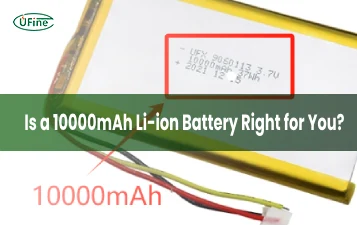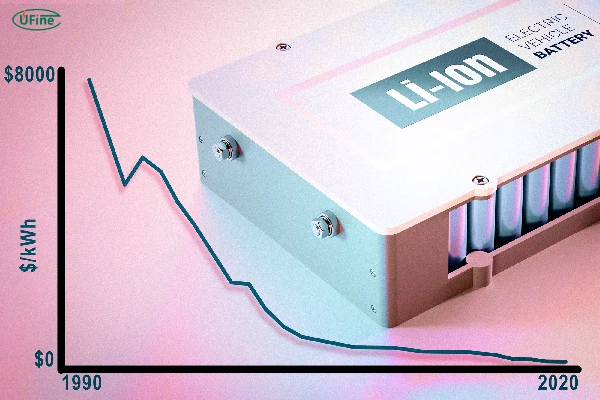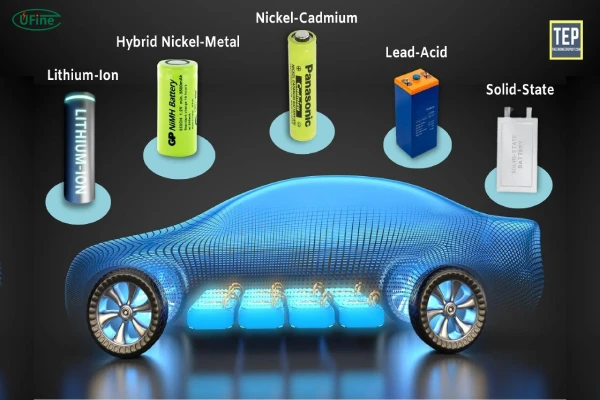As the global automotive industry shifts toward electrification, lithium car batteries have emerged as the most efficient, reliable, and sustainable energy storage solution. Their high energy density, extended lifespan, and lightweight composition make them a superior alternative to traditional lead-acid batteries, transforming the way vehicles store and utilize power.
However, the realm of lithium car batteries is vast and complex, with multiple chemistries, performance attributes, and application-specific considerations. This guide provides an in-depth exploration of lithium car batteries, covering their functions, types, comparisons, and key selection factors. Whether you are an electric vehicle (EV) enthusiast, an automotive engineer, or a consumer looking for battery replacement options, this article will provide the technical insights needed to make an informed decision.
Part 1. Understanding lithium car batteries
Lithium car batteries are a category of rechargeable batteries that rely on lithium-ion technology to store and discharge electrical energy efficiently. These batteries have revolutionized vehicle electrification by offering superior performance metrics compared to conventional lead-acid batteries.
Lead Acid vs. Lithium Ion Batteries: A Complete Comparison
Key Functional Aspects of Lithium Car Batteries
- Primary Energy Storage for EVs: In electric vehicles (EVs) and hybrid electric vehicles (HEVs), lithium batteries serve as the primary energy source, supplying power to the traction motor.
- Powering Auxiliary Systems: In addition to propulsion, lithium batteries support auxiliary electrical components, including lighting, air conditioning, infotainment systems, and electronic control units (ECUs).
- Regenerative Braking Energy Recovery: Advanced EVs and hybrids utilize lithium-ion batteries to capture and store energy recovered from regenerative braking systems, enhancing efficiency and extending driving range.
- Sustained Performance Across Extended Lifecycles: Lithium car batteries boast a significantly longer operational lifespan, often exceeding 10 years, depending on battery chemistry and usage patterns.
The shift toward lithium-ion technology is primarily driven by its high energy-to-weight ratio, fast charging capabilities, and lower self-discharge rates. However, the specific characteristics of lithium batteries vary based on the chemistry used in their construction.
Part 2. What kind of battery does a car require?
A vehicle’s battery requirements depend on multiple factors, including propulsion type, power demands, and expected lifespan. Broadly, automotive batteries can be categorized into the following types:
1. Starting, Lighting, and Ignition (SLI) Batteries
- Designed to deliver short bursts of high power to start internal combustion engines.
- Typically lead-acid batteries, but lithium alternatives exist for lightweight, high-performance applications.
2. Deep-Cycle Batteries
- Engineered for sustained power delivery over extended periods.
- Commonly found in hybrid and electric vehicles for energy storage and propulsion.
3. Lithium-Ion Batteries (Li-Ion)
- The dominant choice for modern EVs due to high energy density and efficiency.
- Supports rapid charging and deep discharge cycles.
4. Lithium Iron Phosphate (LiFePO4) Batteries
- A subset of lithium-ion batteries with enhanced safety and thermal stability.
- Increasingly adopted in electric vehicle applications.
For traditional gasoline and diesel-powered cars, SLI batteries (often lead-acid) suffice. However, electric and hybrid vehicles require lithium-ion or lithium-iron-phosphate batteries to meet energy and efficiency demands.
Part 3. Types of lithium car batteries
Lithium car batteries come in various chemistries, each offering distinct advantages and trade-offs. The most prominent types include:
1. Lithium Iron Phosphate (LiFePO4)
- Advantages: Exceptional thermal stability, high safety, long lifespan (up to 5,000 charge cycles).
- Limitations: Lower energy density compared to other lithium-ion chemistries.
- Common Uses: Electric cars, motorcycles, and backup power systems.
2. Lithium Cobalt Oxide (LiCoO2)
- Advantages: High energy density, compact design, lightweight.
- Limitations: Shorter lifespan, safety concerns due to thermal instability.
- Common Uses: Consumer electronics, some early EVs.
3. Lithium Manganese Oxide (LiMn2O4)
- Advantages: Enhanced thermal stability, moderate lifespan.
- Limitations: Moderate energy density, degradation over time.
- Common Uses: Power tools, electric bicycles, select hybrid vehicles.
4. Lithium Nickel Manganese Cobalt Oxide (NMC)
- Advantages: High energy density, balanced performance in terms of power and safety.
- Limitations: Expensive, moderate lifespan.
- Common Uses: Most modern electric cars, plug-in hybrids.
5. Lithium Nickel Cobalt Aluminum Oxide (NCA)
- Advantages: Extremely high energy density, used in performance-oriented EVs.
- Limitations: Lower safety margin, shorter cycle life.
- Common Uses: Tesla vehicles, high-performance EVs.
6. Lithium Titanate (LTO)
- Advantages: Ultra-fast charging, exceptional lifespan (up to 10,000 cycles).
- Limitations: Lower energy density, expensive.
- Common Uses: Heavy-duty industrial vehicles, commercial EV fleets.
7. Solid-State Lithium Batteries (Next-Gen Technology)
- Advantages: Higher energy density, better safety, longer lifespan.
- Limitations: High cost, still under development.
- Common Uses: Future electric vehicles and high-performance applications.
Part 4. Comparative analysis of lithium car battery types
To better understand the differences between various lithium car battery types, the following comparison table outlines their key characteristics:
| Battery Type | Energy Density | Lifespan (Charge Cycles) | Safety | Cost | Applications |
|---|---|---|---|---|---|
| LiFePO4 | Moderate | 2,000–5,000 | Very Safe | Medium | EVs, hybrids, backup power |
| LiCoO2 | High | 500–1,000 | Low | High | Consumer electronics, some EVs |
| LiMn2O4 | Moderate | 1,000–2,000 | High | Medium | Power tools, some EVs |
| NMC | High | 1,000–2,500 | Moderate | High | Most EVs, hybrids |
| NCA | Very High | 1,000–2,000 | Moderate | High | Tesla, high-performance EVs |
| LTO | Low | 10,000+ | Very High | Very High | Industrial, heavy-duty EVs |
| Solid-State | Extremely High | TBD | Very High | Extremely High | Future EVs |
Part 5. How to choose the right lithium car battery?
When selecting a lithium car battery, the following criteria should be assessed:
- Energy Requirements: Higher energy density (NMC, NCA) for long-range EVs; safer chemistry (LiFePO4) for everyday use.
- Lifespan: If longevity is a priority, LTO or LiFePO4 batteries outperform other types.
- Charging Speed: LTO offers the fastest charging times; NMC and NCA support rapid charging.
- Safety Profile: LiFePO4 and solid-state batteries provide the highest safety margins.
- Cost Efficiency: NMC strikes a balance between performance and affordability.
- Environmental Impact: LiFePO4 batteries have the lowest ecological footprint.
Part 6. FAQs
1. What are the key benefits of using a Lithium Car Battery instead of a lead-acid battery?
A Lithium Car Battery provides higher energy density, lighter weight, longer lifespan, faster charging, and improved efficiency compared to traditional lead-acid batteries. It also has a lower self-discharge rate, reducing energy loss when the vehicle is parked for extended periods.
2. How does battery degradation affect the performance of a Lithium Car Battery?
Over time, a Lithium Car Battery loses its ability to hold a full charge, leading to a reduction in driving range and overall efficiency. Most modern lithium batteries retain 70–90% of their original capacity even after 100,000–200,000 miles, depending on usage and maintenance.
3. Is a Lithium Car Battery compatible with all electric and hybrid vehicles?
Not all Lithium Car Batteries are interchangeable. Vehicles use specific lithium chemistries (NMC, NCA, or LiFePO4) tailored to their power requirements. When replacing a battery, it’s important to ensure compatibility with the voltage, capacity, and charging system of the vehicle.
4. How does Vehicle-to-Grid (V2G) technology work with a Lithium Car Battery?
A Lithium Car Battery in an EV can store excess electricity and send it back to the power grid during peak demand. Vehicle-to-Grid (V2G) technology enhances energy efficiency, reduces electricity costs, and supports the integration of renewable energy sources.
5. How do automakers improve Lithium Car Battery safety?
To enhance safety, automakers incorporate thermal management systems, fire-resistant materials, and advanced Battery Management Systems (BMS) to prevent overheating, short circuits, and thermal runaway. Future developments, like solid-state lithium car batteries, promise even higher safety standards and stability.
Related Tags:
More Articles

10000mAh Battery Explained: How Long It Lasts, How It Works
A full guide on 10000mAh li-ion batteries, voltage, usage time, and tips. Discover how a 10000mAh battery works, how long it lasts, and how to choose.
10440 Battery Guide: Size, Voltage, Capacity, Uses & More
Understand 10440 batteries better—size, voltage, safety, and how they compare to AAA. Find the best fit for your high-performance devices.
White Stuff on Battery Terminals: A Step-by-Step Cleaning and Maintenance Guide
White stuff on battery terminals is corrosion. Learn how to clean it safely, prevent damage, and keep your battery running strong with simple steps.
Understanding How Glass Mat Batteries Work: Technology, Benefits, and Limitations
Glass mat batteries power cars, RVs, and solar systems. Learn how they work, their benefits, and what to consider before choosing one.
A Buyer’s Guide for AA Size Lithium Battery
Discover the power of AA size lithium batteries—types, voltage, capacity, and more! Learn how to choose the best one for your needs. Read now!





